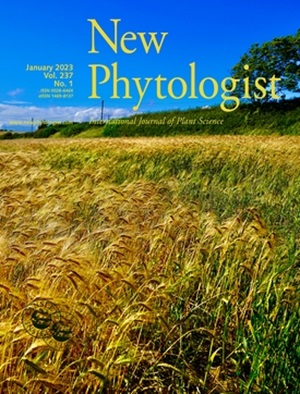功能表征揭示了拟南芥 ECA4 和 EPSIN3 在凝集素介导的内吞和顶端生长细胞壁结构中的重要性。
IF 8.3
1区 生物学
Q1 PLANT SCIENCES
引用次数: 0
摘要
局部凝集素介导的内吞对植物顶端生长细胞的分泌和壁沉积至关重要。众所周知,适配蛋白和信号蛋白以及磷脂在这一过程中发挥着调节作用,但其作用尚不明确。在这里,我们研究了拟南芥 ECA4 和 EPSIN3 在花粉管和根毛中的功能。同基因 eca4 和 epsin3 植物的花粉管形态(体外)发生了改变,自花授粉会导致种子减少和蓇葖果变短。这些影响在 eca4/epsin3 双突变体中得到了加强,定量聚合酶链反应数据显示,磷脂代谢和开花基因发生了变化,表明存在协同作用。根的形态没有明显变化,但原子力显微镜观察发现突变体根毛的结构硬度发生了变化。对 ECA4 和 EPSIN3 X-FP 构建体的成像和 FRET-FLIM 分析表明,这两种蛋白质在质膜上相互作用,但在细胞内的定位略有不同。对突变体细胞进行的 FT-ICR-MS 代谢组学分析表明,脂质、氨基酸和碳水化合物组成的变化与分泌和生长中的作用一致。带有磷脂酶 C 基因(plc5、plc7)的 ECA4 和 EPSIN3 双突变体的特征表明,磷脂肌醇(如 PtdIns(4,5)P2)是 ECA4-EPSIN3 在细胞分泌中发挥联合和互补作用的基础。本文章由计算机程序翻译,如有差异,请以英文原文为准。
Functional characterization reveals the importance of Arabidopsis ECA4 and EPSIN3 in clathrin mediated endocytosis and wall structure in apical growing cells
- Localized clathrin mediated endocytosis is vital for secretion and wall deposition in apical growing plant cells. Adaptor and signalling proteins, along with phosphoinositides, are known to play a regulatory, yet poorly defined role in this process. Here we investigated the function of Arabidopsis ECA4 and EPSIN3, putative mediators of the process, in pollen tubes and root hairs.
- Homozygous eca4 and epsin3 plants exhibited altered pollen tube morphology (in vitro) and self-pollination led to fewer seeds and shorter siliques. These effects were augmented in eca4/epsin3 double mutant and quantitative polymerase chain reaction data revealed changes in phosphoinositide metabolism and flowering genes suggestive of a synergistic action. No visible changes were observed in root morphology, but atomic force microscopy in mutant root hairs showed altered structural stiffness.
- Imaging and FRET-FLIM analysis of ECA4 and EPSIN3 X-FP constructs revealed that both proteins interact at the plasma membrane but exhibit slightly different intracellular localization. FT-ICR-MS metabolomic analysis of mutant cells showed changes in lipids, amino acids and carbohydrate composition consistent with a role in secretion and growth.
- Characterization of double mutants of eca4 and epsin3 with phospholipase C genes (plc5, plc7) indicates that phosphoinositides (e.g. PtdIns(4,5)P2) are fundamental for a combined and complementary role of ECA4-EPSIN3 in cell secretion.
求助全文
通过发布文献求助,成功后即可免费获取论文全文。
去求助
来源期刊

New Phytologist
生物-植物科学
自引率
5.30%
发文量
728
期刊介绍:
New Phytologist is an international electronic journal published 24 times a year. It is owned by the New Phytologist Foundation, a non-profit-making charitable organization dedicated to promoting plant science. The journal publishes excellent, novel, rigorous, and timely research and scholarship in plant science and its applications. The articles cover topics in five sections: Physiology & Development, Environment, Interaction, Evolution, and Transformative Plant Biotechnology. These sections encompass intracellular processes, global environmental change, and encourage cross-disciplinary approaches. The journal recognizes the use of techniques from molecular and cell biology, functional genomics, modeling, and system-based approaches in plant science. Abstracting and Indexing Information for New Phytologist includes Academic Search, AgBiotech News & Information, Agroforestry Abstracts, Biochemistry & Biophysics Citation Index, Botanical Pesticides, CAB Abstracts®, Environment Index, Global Health, and Plant Breeding Abstracts, and others.
 求助内容:
求助内容: 应助结果提醒方式:
应助结果提醒方式:


